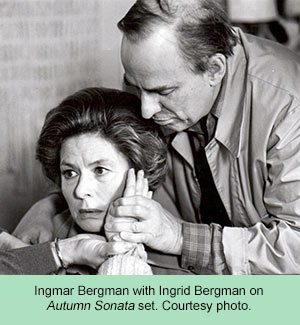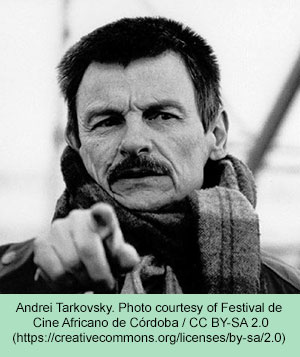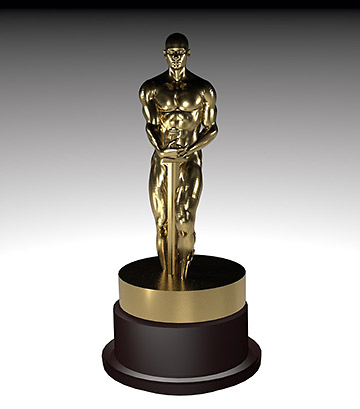Trivia 70: The Bard of Avon
Trivia # 70 Shakespeare

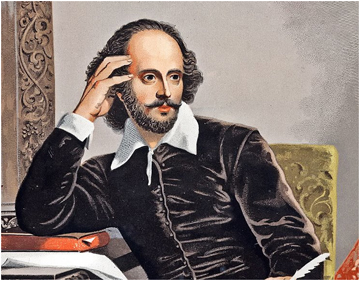
Congratulations!
You have completed Trivia # 70 Shakespeare.

You scored %%SCORE%% out of %%TOTAL%%.
Your performance has been rated as %%RATING%%
Question 1 |
A | TRUE |
B | FALSE |
Answer: B. FALSE

Shakespeare’s parents were probably illiterate, and his children almost certainly were. Nobody knows for sure, but it’s quite likely that John and Mary Shakespeare never learned to read or write, as was often the case for people of their standing during the Elizabethan era
Question 2 |
A | A Midsummer Night’s Dream |
B | All's Well That Ends Well |
C | Much Ado About Nothing |
D | Othello |
E | Romeo and Juliet |
A. A Midsummer Night’s Dream was set in Athens
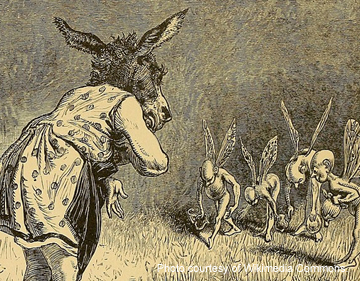
Shakespeare set A Midsummer Night’s Dream in ancient Athens and the wood just outside it, which Shakespeare changes into a magic place with fairies. There is a fairy king and a fairy queen. The King exercises his magical power over the young lovers as they fall in and out of love at his bidding.
Alls Well That Ends Well | Florence
“All’s Well That Ends Well” is a complicated tale of love and war whereby Helena is in love with Bertram and the feeling is not mutual. She follows Bertram to Paris and compels him to marry her, but he flees to Florence to fight in the Tuscan War. After much intrigue and conflict, Bertram accepts Helena as his wife and they live happily ever after. Both Florence and Tuscany are featured throughout this play and are ideal destinations for any Italian tour.
Romeo and Juliet | Verona
“Romeo and Juliet” is Shakespeare’s ultimate tragic love story. It tells of two star-crossed lovers from fair Verona, Romeo Montague and Juliet Capulet. With their two noble families at war with each other, Romeo and Juliet marry in secret. Their union meets a shocking and tragic end. Visitors flock to Juliet’s House (Casa di Giulietta) in Verona and stand on her balcony to recite the famous line, “O Romeo, Romeo, wherefore art thou Romeo?”
Much Ado About Nothing | Sicily
Set in Messina, Sicily, “Much Ado About Nothing” is a comedy full of fun, frivolity and misunderstandings. The play centers around two couples who take many detours on their path to true love. The mix-up is a common Shakespearean technique, and this play uses it to hilarious effect. The warm and tropical seaport of Sicily is the perfect setting for this romantic comedy, with many scenes taking place in Leonato’s luscious outdoor garden.
Othello | Venice
“Othello” is a Shakespearean tragedy that examines themes of revenge, racism and jealousy. The tragic hero, Othello, is a Moor and a respected general of the Venetian army. His life is destroyed by the devious plotting of an envious soldier, Iago. The thriving city and canals of Venice are the setting for much of the action in Othello. Modern travelers frequent Palazzo ContariniFasan, or Desdemona’s House, named for Othello’s ill-fated wife.
Question 3 |
A | Richard Burton |
B | Mel Gibson |
C | John Gielgud |
D | Douglas Fairbanks, Jr. |
E | Nicol Williamson |
ANSWER: D. Douglas Fairbanks, Jr.
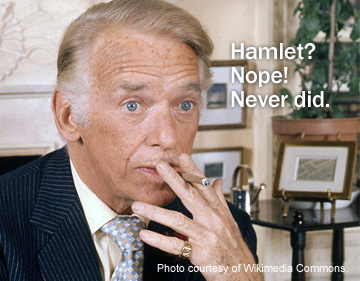
Question 4 |
A | All that glitters is not gold. |
B | All the world's a stage. |
C | Did doth science gage happiness? I doth not believeth 't. |
D | Good night, good night! Parting is such sweet sorrow. |
E | There are more things in Heaven and Earth, Horatio, than are dreamt of in your philosophy. |
Answer: C. "Did doth science gage happiness? I doth not believeth 't."
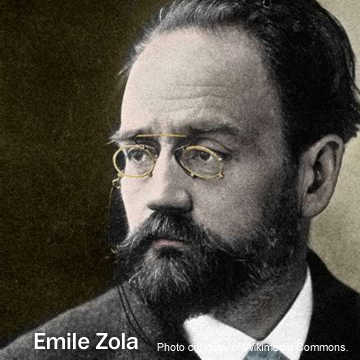
All the world's a stage
And all the men and women merely players:
They have their exits and their entrances;
And one man in his time plays many parts.
-As You Like It, Act II, Scene VII
"All that glitters is not gold."
-The Merchant of Venice, Act II, Scene VII
“Good night, good night! Parting is such sweet sorrow,
That I shall say good night till it be morrow.”
-Romeo and Juliet, Act II, Scene II
There are more things in Heaven and Earth, Horatio, than are dreamt of in your philosophy.
-Hamlet, Sonnet 18
Question 5 |
Name the writer who historians did not consider to be the REAL Bard of Avon.
A | Francis Bacon |
B | Emilia Bassano |
C | Charles Dickens |
D | Edward de Vere |
ANSWER: C. Charles Dickens
Charles Dickens was a British novelist, journalist, editor, illustrator and social commentator who wrote such beloved classic novels as Oliver Twist, A Christmas Carol, Nicholas Nickleby, David Copperfield, A Tale of Two Cities and Great Expectations.
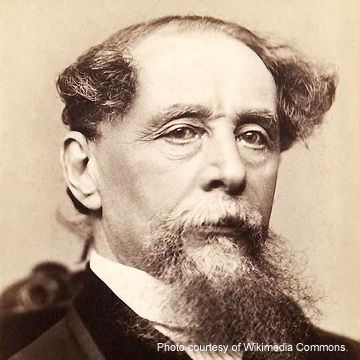
Francis Bacon was an English Renaissance statesman and philosopher, best known for his promotion of the scientific method.
Emilia Bassano was one of the first English women to publish a volume of poetry. Historians believe Bassano’s family were likely converted Jews, and the inclusion of Jewish characters and themes, treated in a more positive way than by many other authors of the day, could be explained by Bassano’s authorship.
Christopher Marlowe was a poet and playwright, considered the father of English tragedies.
Edward de Vere, the 17th Earl of Oxford, was a poet, dramatist and world traveler.
Trivia #45

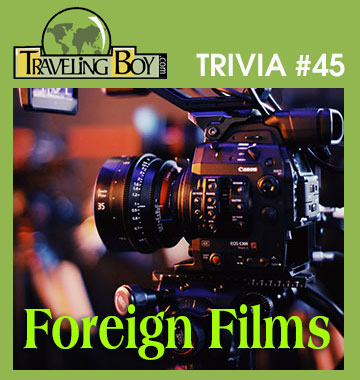
How well do you know World Cinema? You can find out here in our 45th installment of Traveling Boy’s Global Cinema Trivia Game. No one will see your answers except you.
Global Trivia 45
Congratulations!
You have completed Global Trivia 45.

You scored %%SCORE%% out of a possible 5 points.
Your performance was: %%RATING%%
Question 1 |
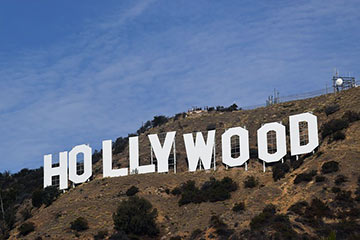
Name the Hollywood actor who was NOT foreign born.
A | Hedy Lamar |
B | Mel Gibson |
C | Zsa Zsa Gabor |
D | Greta Garbo |
E | Donald Sutherland |
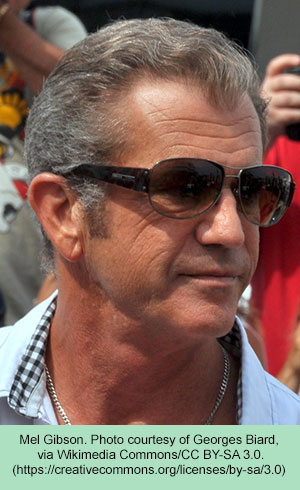
Mel Columcille Gerard Gibson was born January 3, 1956 in Peekskill, New York, as the sixth of eleven children of Hutton Gibson, a railroad brakeman, and Anne Patricia (Reilly) Gibson (who died in December of 1990). His mother was Irish, from County Longford, while his American-born father is of mostly Irish descent. Mel and his family moved to Australia in the late 1960s, settling in New South Wales.
Zsa Zsa Gabor; born Sári Gabor on February 6, 1917 in Budapest, Austria-Hungary (now Hungary).
Hedy Lamar; born November 9, 1914 in Vienna, Austria-Hungary (now Austria).
Greta Garbo; born Greta Lovisa Gustafsson on September 18, 1901, in Stockholm, Sweden.
Donald Sutherland: born July 17, 1935 in Saint John, New Brunswick, Canada.
Question 2 |
Name the French New Wave (La Nouvelle Vague) director who was NOT initially a film critic for "Cahiers du Cinéma."
A | Claude Chabrol |
B | Alain Resnais |
C | Jean-Luc Godard |
D | Éric Rohmer |
E | François Truffaut |
F | Jacques Rivette |
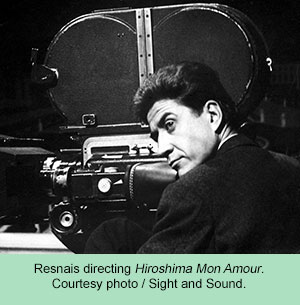
Alain Resnais (1922 – 2014) was part of the French New Wave’s Left Bank Group, along with Chris Marker, Agnes Varda and Jacques Demy (Varda’s husband). Resnais was a director and editor of award-winning documentary films, before moving on to theatrical films with the release of Hiroshima Mon Amour (1959). The film, along with Truffaut’s first feature, Les Quatre Cents Coups (The 400 Blows) (1959) premièred at the 1959 Cannes Film Festival which led them both to world-wide fame.
Claude Chabrol (1930–2010)
Éric Rohmer; born Jean-Marie Maurice Schérer (1920–2010)
François Truffaut (1932–1984)
Jean-Luc Godard (1930 – )
Jacques Rivette (1928–2016)
Question 3 |

This legendary Japanese film director was famous for his innovation of the Tatami-style camera setup.
A | Kon Ichikawa |
B | Akira Kurosawa |
C | Kenji Mizoguchi |
D | Nagisa Ôshima |
E | Yasujirô Ozu |
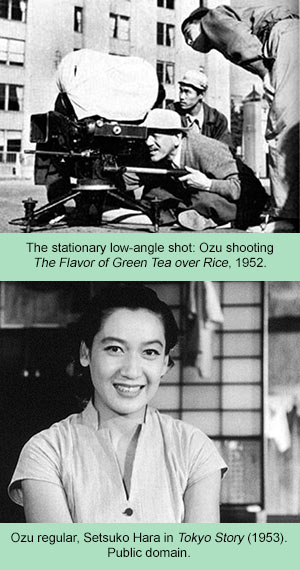
Ozu’s innovative Tatami-style camera setup consists of a rigorous use of static camera positioned only a few feet from floor. Ozu felt that this camera angle best reflected Japanese life. Ozu’s most famous film, Tokyo Story (1953), is generally considered by critics and film buffs alike to be his "masterpiece" and is regarded as one of the best films ever made. It is also my favorite film of all time. The camera moves just once in the entire film. He also turned out such classics of Japanese film as I Was Born, But... (1932), The Flavor of Green Tea Over Rice (1952), Floating Weeds (1959) and An Autumn Afternoon (1962).
Akira Kurosawa
Kenji Mizoguchi
Nagisa Ôshima
Kon Ichikawa
Question 4 |
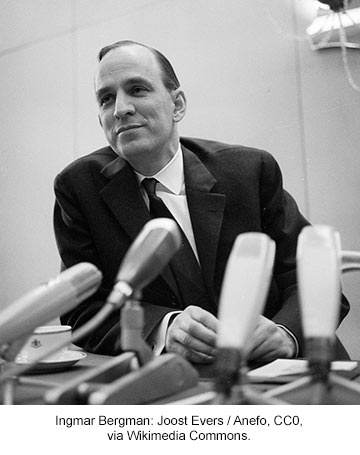
Name the only Ingmar Bergman film in which Ingrid Bergman appeared.
A | Persona |
B | Cries and Whispers |
C | Through a Glass Darkly |
D | Autumn Sonata |
E | Smiles of a Summer Night |
Question 5 |
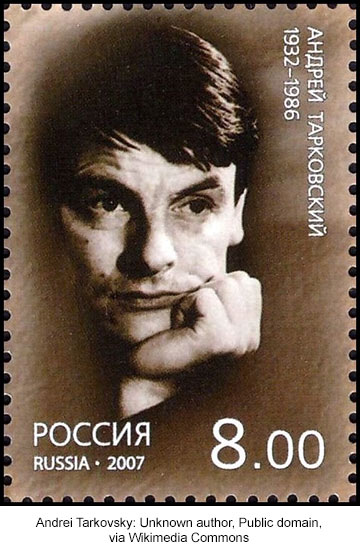
Name the film NOT directed by Andrei Tarkovsky.
A | The Sacrifice |
B | Russian Ark |
C | Stalker |
D | Solaris |
E | Andrei Rublev |
Oscar Trivia: Part II

The 94th Academy Awards are just around the corner, but there’s still plenty of time to participate in Traveling Boy’s Oscar Trivia: Part II. No one will see your answers except for you.
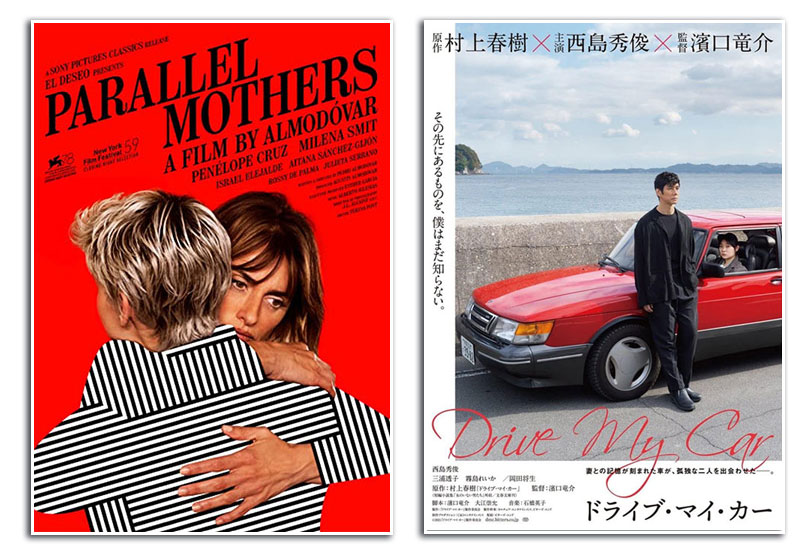
Global Trivia 58 Oscars 2
Congratulations!
You have completed Global Trivia 58 Oscars 2.

You scored %%SCORE%% out of a possible 5 points.
Your performance was: %%RATING%%
Question 1 |
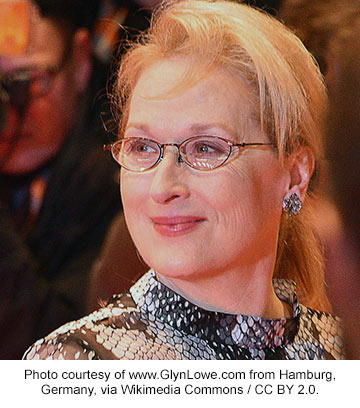
Meryl Streep has won the most Oscars for Best Actress.
A | True |
B | False |
Katharine Hepburn (1907-2003) was an American actress of film, stage, and television. Her career spanned 66 years and eight decades (1928 - 1994), during which time she was nominated for a total of 12 Academy Awards for Best Actress, and won four – the record number of wins for a performer.
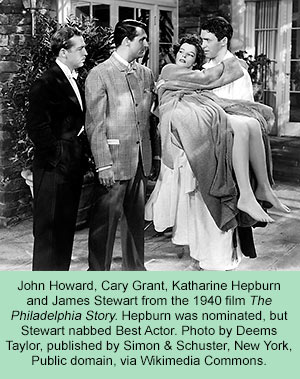
Katharine Hepburn Best Actress Oscars
1933: Morning Glory
1967: Guess Who’s Coming to Dinner
1968: The Lion in Winter (tied with Barbra Streisand for Funny Girl)
1981: On Golden Pond
Question 2 |

This film won the Academy Award, NY Film Critics Circle and National or Society of Film Critics Association for Best Picture and Director.
A | All the President's Men |
B | Doctor Zhivago |
C | The Hurt Locker |
D | Millions Dollar Baby |
E | Unforgiven |
The Hurt Locker won the Academy Award, NY Film Critics Circle Award and the National Society of Film Critics Association Awards for Best Picture and Director, Kathryn Bigelow.
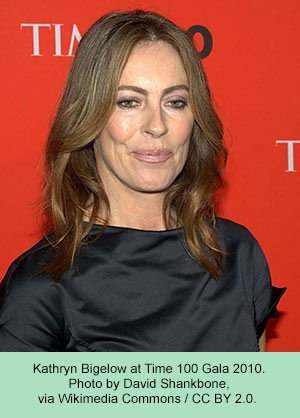
Kathryn Bigelow Filmography
2017: Detroit
2012: Zero Dark Thirty
2008: The Hurt Locker
2002: K-19: The Widowmaker
2000: The Weight of Water
1995: Strange Days
1991: Point Break
1990: Blue Steel
1987: Near Dark
1981: The Loveless
Question 3 |

Name the first African Actress who won a Best Actress Oscar in a leading role.
A | Halle Berry |
B | Whoopi Goldberg |
C | Hattie McDaniel |
D | Lupita Nyong'o |
E | Charlize Theron |
One of the most note-worthy physical transformations was Charlize Theron's portrayal of serial killer and former prostitute Aileen Wuornos in Monster, which won her an Oscar for Best Actress. Prior to this role, Theron was athletic and had to put on weight, on top of masking her face with makeup and prosthetic teeth.
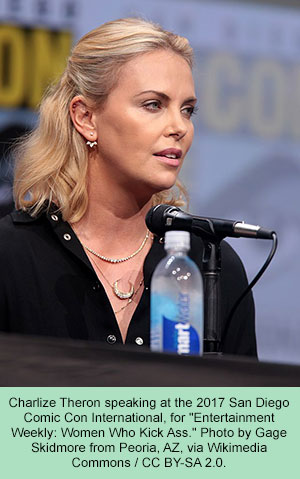
Charlize Theron was born August 7, 1975 in Benoni, a city in the greater Johannesburg area, in South Africa. She was raised on a farm outside the city. Theron is of Afrikaner (Dutch, with some French Huguenot and German) descent.
Question 4 |

Name the foreign-born actor who won a Best Actor Oscar in a leading role, speaking two different languages.
A | Richard Burton |
B | Jean Gabin |
C | Bruno Ganz |
D | Maximilian Schell |
E | Paul Scofield |
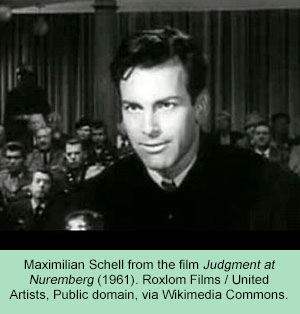
Maximilian Schell (1930 –2014) was an Austrian-born Swiss film and stage actor, who also wrote, directed and produced some of his own films. He won the Academy Award for Best Actor for the 1961 American film Judgment at Nuremberg, his second acting role in Hollywood. In the film he spoke both German and English.
Question 5 |
Name the foreign-born actress who won Best Supporting Actress playing an Academy Award Winning Actress.
A | Julie Andrews |
B | Cate Blanchett |
C | Judy Dench |
D | Faye Dunaway |
E | Glenda Jackson |
Cate Blanchett won a Best Supporting Actress Oscar playing the Academy Award Winning Actress Katherine Hepburn in Martin Scorsese's film Aviator.
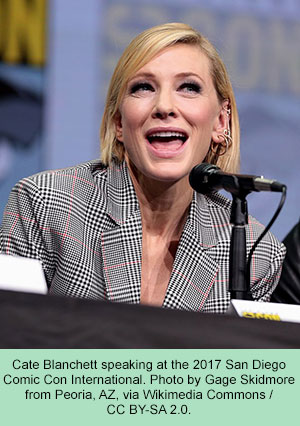
Cate Blanchett was born on May 14, 1969 in Melbourne, Victoria, Australia.
Blanchett is married to producer and writer Andrew Upton, known for Carol (2015), Stories of Lost Souls (2005) and Babe (1995). Her breakthrough role was the title character in the film, Elizabeth (1998).
Because of her raising four children in Australia, her film work became sporadic, until Woody Allen cast her in the title role in Blue Jasmine (2013), which won her the Academy Award as Best Actress.
Oscar Trivia: Academy Award Winners in Non-English Speaking Films

With the Academy Awards around the corner, and broadcasted across the globe, Traveling Boy’s new trivia game features Oscar winners in non-English speaking films. No one will see your answers except for you.

Global Trivia 57 Oscars 1
Congratulations!
You have completed Global Trivia 57 Oscars 1.

You scored %%SCORE%% out of a possible 5 points.
Your performance was: %%RATING%%
Question 1 |

Name the only Foreign Language film that won Best Picture in the main category.
A | The Bicycle Thief (1947, Italy), directed by Vittorio De Sica |
B | The Discreet Charm of the Bourgeoisie (1972, France), directed by Luis Buñuel |
C | Fanny and Alexander (1983, Sweden), directed by Ingmar Bergman |
D | Parasite (2020, South Korea), directed by Bong Joon-ho |
E | Raise the Red Lantern (1991, Hong Kong) directed by Zhang Yimou |
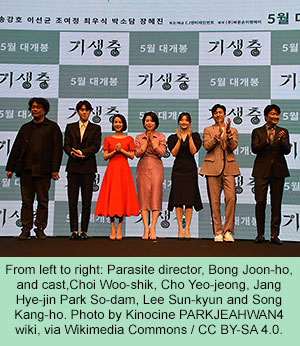
In 2020, Parasite made history with Best Screenplay and a Best Director wins for Bong Joon Ho, and in addition its win for Best International Film, became the first film not in English to win Best Picture at the Oscars in a very competitive year for the Academy's top award.
Question 2 |

Name the first actress to win an Academy Award for Best Actress for a foreign language performance.
A | Catherine Deneuve |
B | Marlene Dietrich |
C | Gong Li |
D | Sophia Loren |
E | Emmanuelle Riva |
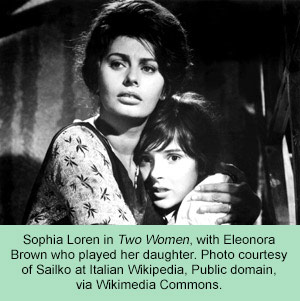
Sophia Loren made history as the first actress to win an Oscar for a foreign language performance in Vittorio De Sica’s Two Women (1960). Her Oscar success, which came for portraying a widow coping with war-torn Italy and her daughter's rape, catapulted her to a new level of international fame, making her one of the biggest stars of the 1960s.
Question 3 |
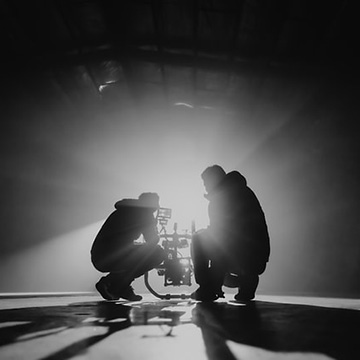
Name the Foreign Language director who has won the most Oscars for Best Foreign Language Film.
A | Ingmar Bergman |
B | Vittorio de Sica |
C | Federico Fellini |
D | Akira Kurosawa |
E | Francois Truffaut |
The late Italian filmmaker Federico Fellini directed four winning motion pictures, La Strada, Nights of Cabiria, 8½, Amarcord, more than any other director. If Special Awards are taken into account, then Fellini's record is tied by his countryman Vittorio De Sica.
Ingmar Bergman – 3 Best Foreign Language Oscars
Vittorio de Sica – 2 Best Foreign Language Oscars
Akira Kurosawa – 2 Best Foreign Language Oscars
Francois Truffaut – 1 Best Foreign Language Oscars
Question 4 |
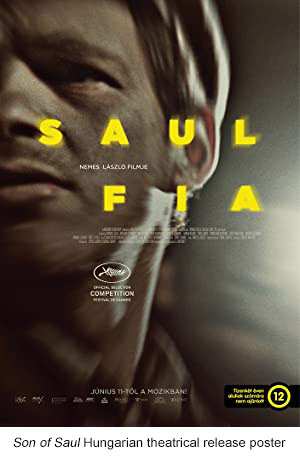
The Hungarian film Son of Saul won an Academy Award for Best Foreign language film.
A | True |
B | False |
Son of Saul (Saul fia) is a 2015 Hungarian drama film directed by László Nemes, in his feature directorial debut, and co-written by Nemes and Clara Royer. It is set in the in the Nazi Auschwitz concentration camp and Birkenau extermination camp during World War II. The film follows a day-and-a-half in the life of Saul Ausländer (played by Géza Röhrig), a Hungarian member of the Sonderkommando.
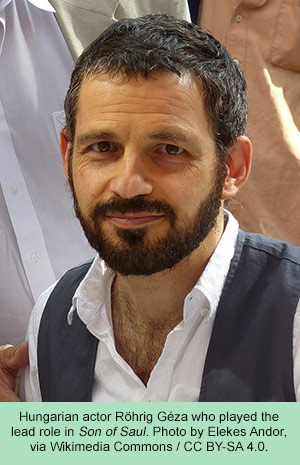
The film premiered at the 2015 Cannes Film Festival, where it won the Grand Prix. It was also shown in the Special Presentations section of the 2015 Toronto International Film Festival. The film won the award for Best Foreign Language Film at the 88th Academy Awards.
Question 5 |
Name the foreign-born actor to win the FIRST Best Actor Oscar.
A | Emil Jannings (Switzerland) |
B | Erland Josephson (Sweden) |
C | Anthony Quinn (Mexico) |
D | Max Schreck (Germany) |
E | Rudolph Valentino (Italy) |
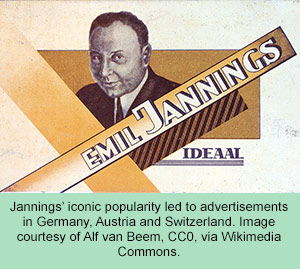
The first Best Actor was awarded to Swiss-born Emil Jannings (1884 – 1950), for his performances in the silent films, The Last Command (1928), directed by Josef von Sternberg, and The Way of All Flesh (1927), with studio contract director Victor Fleming.
The 1st Academy Awards ceremony, presented by the Academy of Motion Picture Arts and Sciences, honored the best films of 1927 and 1928 and took place on May 16, 1929, at a private dinner held at the Hollywood Roosevelt Hotel in Los Angeles, California. The Swiss-German speaking Jannings had to return to Europe before the ceremony, so the Academy agreed to give him the prize earlier; making him the first Academy Award winner in history.
Emil Jannings’ real name was Theodor Friedrich Emil Janenz, and in the early 1900s, his career in German was already getting noticed by his working the theater under Max Reinhardt's company. Reinhardt was a titan of influence and inspiration on a whole generation of theater and film directors in Germany. His staging of crowds, use of expressionist sets, lighting and acting style greatly influenced the great silent filmmakers of the Weimar Republic, including the iconic directors Fritz Lang, F.W. Murnau, Ernst Lubitsch Fritz Lang and Otto Preminger.
Jannings film career took to new heights due to his association with F.W. Murnau and Josef von Sternberg, both considered Pantheon Directors by film historians.
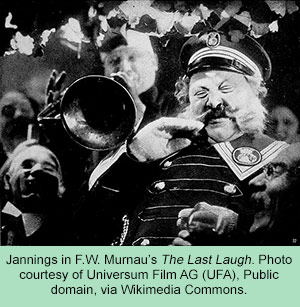
Jannings and F.W. Murnau
Jannings appeared in Murnau’s 1924 silent film masterpiece, The Last Laugh. Murnau’s unparalleled use of the unchained camera (no doubt borrowed From D. W. by Griffith), took long camera tracking shots to its greatest glory without the interruption of title cards. The narrative was conveyed in purely visual terms with not a word spoken. The Last Laugh stands not only as a triumph of German cinema, but remains a towering cinematic masterpiece, a masterpiece taught in cinema studies programs today throughout the world. The success of The Last Laugh led Murnau to Hollywood where he made another silent film, Sunrise (1927), considered even a greater achievement than The Last Laugh. Murnau died in an automobile accident at age 42.
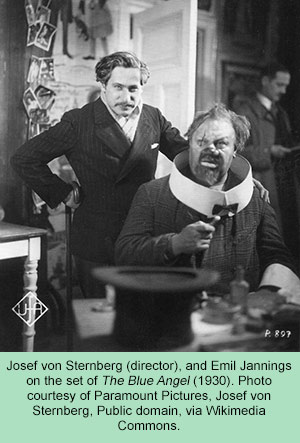
Jannings and Joseph von Sternberg
The Blue Angel (1930) was Germany’s first major sound film, and Jannings uncomfortable doing his own first sound film, nervously requested for Joseph von Sternberg to go to Berlin and direct it. Von Sternberg gambled by casting Marlene Dietrich, then obscure, as the seductress Lola Lola, the night-club dancer, who leads Jannings' character into depravity. The von Sternberg-Dietrich story, both on-screen and off (Sternberg’s directed her in six more movies) became one of her legions of lovers. Von Sternberg’s films of the mid-'30s are among the most visionary ever made in Hollywood, but in spite of their visual sumptuousness and use of light, contemporary audiences found them dramatically inert. As American auteurist critic Andrew Sarris commented, during the depressions people cried out for bread, while von Sternberg was giving them cake.
When the Second World War commenced, Jannings concentrated on theater and dedicated his acting skills to the Nazi regime and also took part in the realization of Uncle Kruger (1941), an expensive anti-British film production. When the Second World War ended, the US government cleaned his image, and he converted to Catholicism. He played in a few more German movies, but his career never recaptured its brilliance.
Super Bowl Trivia
Super Bowl Trivia

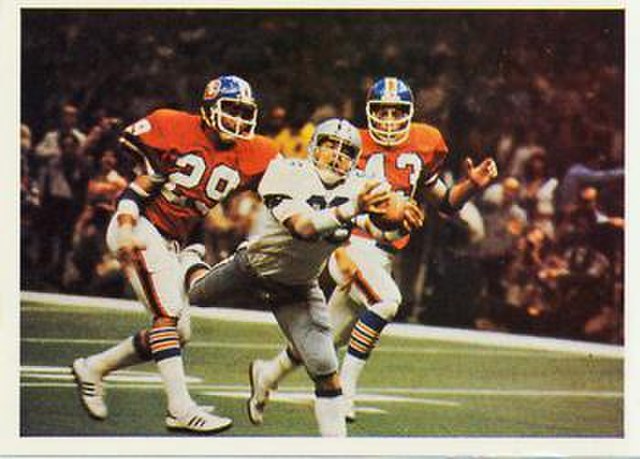
Dallas wide receiver Butch Johnson makes a spectacular, diving catch of a 45-yard touchdown pass from Roger Staubach, as the Cowboys defeat Denver 27-10 in Super Bowl XII. Photo from Wikimedia.org.

You scored %%SCORE%% out of %%TOTAL%%. Your performance has been rated as %%RATING%%
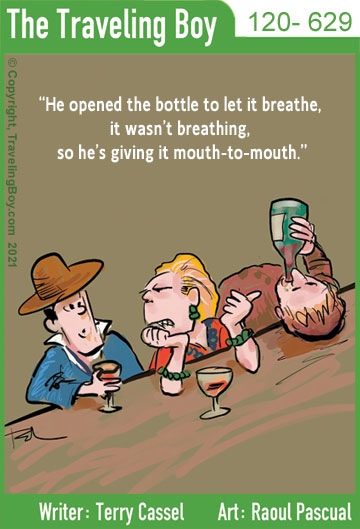 We hope you had fun!
We hope you had fun! Question 1 |
A | True |
B | False |
Answer: A. True
Question 2 |
A | Arizona Cardinals |
B | Atlanta Falcons |
C | Cleveland Browns |
D | Detroit Lions |
E | Minnesota Vikings |
Answer: D. Detroit Lions
Start Year: 1961 – Drought: 62- Detroit Lions -– Start Year: 1961 – Drought -62
- Arizona Cardinals -– Start Year: 1960 – Drought: 61
- Minnesota Vikings -– Start Year: 1961 – Drought: 61
- Cleveland Browns -– Start Year: 1965 – Drought: 57
- .Atlanta Falcons -– Start Year: 1966 – Drought: 56
- Los Angeles Chargers -– Start Year: 1966 – Drought: 56
Question 3 |
A | Terry Bradshaw (Steelers) |
B | John Elway (Broncos) |
C | Peyton Manning (Colts/Broncos) |
D | Joe Montana (49ers) |
E | Roger Staubach (Cowboys) |
Answer: B. John Elway (Broncos)- 5
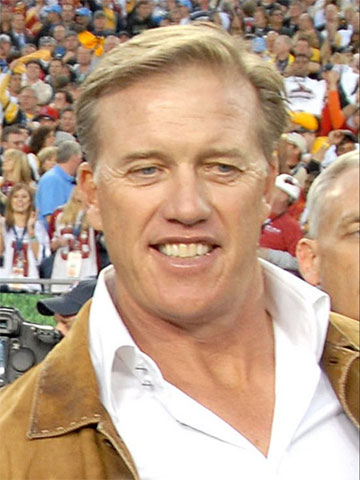
Elway
- Tom Brady (Patriots/Buccaneers) -10
- John Elway (Broncos) - 5
- Joe Montana (49ers) - 4
- Peyton Manning (Colts/Broncos) - 4
- Terry Bradshaw (Steelers) - 4
- Jim Kelly (Bills) - 4
- Roger Staubach (Cowboys) - 4
Question 4 |
A | True |
B | False |
Answer: True
Up until the 1990s, the Super Bowl halftime shows primarily consisted of marching bands, drill teams and jazzy tribute groups like “Up With People.” They were not all the over-the-top extravaganzas of today.
Question 5 |
A | Terry Bradshaw’s touchdown pass to John Stallworth |
B | James Harrison’s return for touchdown |
C | Jacoby Jones’ kickoff return for touchdown |
D | Tracy Porter’s interception return for touchdown |
E | Johnny Unitas’ touchdown pass to John Mackey |
Answer: C. Jacoby Jones’ 108-yard kick return for touchdown
- Super Bowl XLVII, Ravens vs. 49ers
-
James Harrison’s 100-yard interception return for touchdown.
Super Bowl XLIII, Steelers vs. Cardinals
-
Desmond Howard’s 99-yard kick return touchdown
Super Bowl XXXI, Patriots vs. Packers.
-
Doug Williams' 80-yard touchdown pass to Ricky Sanders
Super Bowl XXII, Redskins vs. Broncos -
Johnny Unitas’ 75-yard touchdown pass to John Mackey
Super Bowl V, Colts vs. Cowboys
Trivia #13
TBoy Christmas Special


No one will see your answers except for you. - EB
INSTRUCTIONS: You have multiple choices. An explanation and a reference comes after every question. There is no fixed order so you can choose from any of the boxes. The SHADED BOXES are what you already answered. Your final score is at the END. Don't hit REFRESH unless you want to start all over. This is part of a continuing series in Traveling Boy.
Congratulations!
You have completed TBoy Christmas Special.

You scored %%SCORE%% out of a possible 5 points.
Your performance was: %%RATING%%

We hope you had fun!
Question 1 |
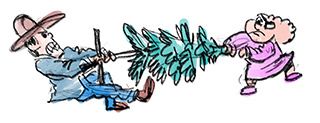
Is saying “Happy Holidays” an assault on “Christmas?”
A | Yes |
B | No |
B. No
If you’ve ever faced an assault from another by joyfully expressing the greeting “Happy Holidays” as opposed to “Merry Christmas,” history is on your side. Both “Happy Holidays” and “Merry Christmas” have religious roots, derived from Old English. Christmas comes from the Roman Catholic term, “Cristes Maesse,” or the “Mass of Christ,” the first usage of which (in 1038) described the Mass held to commemorate Christ’s birth. As for “holiday,” the word emerged in the 1500s as a replacement of the earlier medieval word “haliday,” which itself had supplanted the Old English “haligdæg,” meaning “holy day.”
Question 2 |

Gifts are not a traditional part of Hanukkah, but children are usually given this present.
A | Dreidel |
B | Candles |
C | Chocolate |
D | Gelt |
E | Iced cake with apple slices |
D. Gelt
There are several reasons for giving gelt, according to Chabad.org. One of them is to reward children for studying the Torah. This is a reminder to them that the Jewish people had to be re-educated about the Torah after the Greeks were defeated and the Hellenist ways overturned. The word Hanukkah comes from the word for "education." Children also receive gelt to remind them to give part of their money to charity.
Question 3 |

Who invented the Nativity scene?
A | Francis of Assisi |
B | Catherine the Great |
C | Pope Gregory XIII |
D | Martin Luther |
E | Queen Victoria |
A. Francis of Assisi
When Christians today gather around a nativity scene (manger scene, crib, French: crèche or Italian: presepio) in their homes they continue a tradition that began in the 12th century with Francis of Assisi. He brought a crib and animals into church so that everyone worshipping could feel part of the story. Thus a popular pietistic tradition was born. Many consider the genesis of the nativity scene the first dedicated symbol exclusively devoted to Christmas.
Question 4 |

Potato latkes are generally the centerpiece of a Hanukkah meal. But before the arrival of the potato from Peru what was eaten?
A | Apple Noodle Kugel |
B | Cheese Blintz |
C | Cholopchkes (Stuffed Cabbage) |
D | Round Challah |
E | Sweet Brown Rice Kugel |
B. Cheese Blintz
After the Spanish expelled the Jews from Sicily in 1492, the exiles introduced ricotta cheese pancakes to the Jews of northern Italy. Potato latkes are a more recent Ashkenazi invention that gained popularity in Eastern Europe during the mid 1800s. A series of crop failures in Poland and Ukraine led to mass planting of potatoes, which were easy and cheap to grow. But before potatoes came on the scene, the latke of choice was cheese – generally referred today as a blintz.
Question 5 |

The name Kwanzaa comes from the phrase 'matunda ya kwanza' which means 'first fruits.' Name the language in which it is derived?
A | Afrikaans |
B | Berber |
C | Jamaican |
D | Swahili |
E | African-American Brooklynese dialect |
D. Swahili
Kwanzaa is a seven day festival that celebrates African and African American culture and history. Kwanzaa takes place from 26th December to 1st January. The name Kwanzaa comes from the phrase 'matunda ya kwanza' which means 'first fruits' in the Swahili language (an Eastern African language spoken in countries including Kenya, Uganda, Tanzania, Mozambique and Zimbabwe). Kwanzaa is mostly celebrated in the USA.
Trivia 60
DIRECTORS AND THEIR ACTRESS WIVES, PART 2
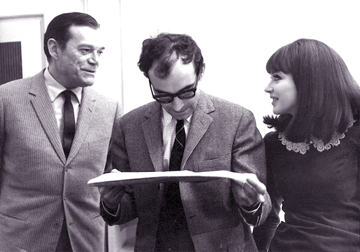
Writer/Director Jean-Luc Godard (center) with Eddie Constantine and wife/actress Anna Karina on the set of Alphaville. Courtesy IMDB.com

Due to the stunning popularity of Trivia 59, the theme for TRIVIA 60 will be the same: FILM DIRECTORS WHO DIRECTED THEIR ACTRESS WIVES.
No one will see your answers except for you.

You scored %%SCORE%% out of %%TOTAL%%. Your performance has been rated as %%RATING%%
In Part 3, More on Directors who directed their Actress Wives.
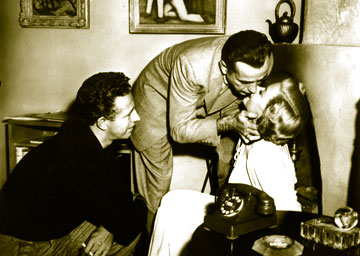 Nicholas Ray directing actress & wife Gloria Grahame and Humphrey Bogart in “In a Lonely Place” (1950) Photo courtesy of Photofest.
Nicholas Ray directing actress & wife Gloria Grahame and Humphrey Bogart in “In a Lonely Place” (1950) Photo courtesy of Photofest. Question 1 |
A | Claire Newman |
B | Melissa Newman |
C | Lee Remick |
D | Eva Marie Saint |
E | Joanne Woodward |
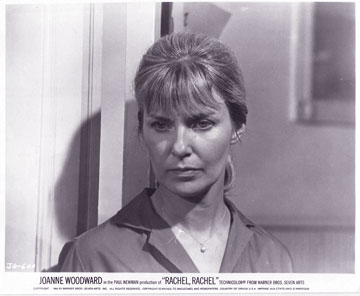
Joanne Woodward in "Rachel, Rachel" (1968). Courtesy IMDB.com
Joanne Gignilliat Trimmier Woodward was born on February 27, 1930, in Thomasville, Georgia, a typical small town in southern Georgia, around ten miles from the Florida border. Growing up in a modest home during the Great Depression, her mother frequently took her to the movies. In her teens, Woodward won many Georgia beauty contests, and enrolled in Louisiana State University, majoring in drama. After graduation and doing small plays, Joanne headed to New York and studied acting.
Soon, Joanne was starring in television productions and theater. One day, she was introduced to another young actor at her level by the then-unknown name of Paul Newman. Paul's first reaction was, "Jeez, what an extraordinarily pretty girl". Joanne, while admitting that he was very good-looking, didn't like him at first sight, but she couldn't resist him. Soon they were working closely together as understudies for the Broadway production of "Picnic." Paul married Joanne in Las Vegas on January 29, 1958, just months before Joanne won her Best Actress Oscar for The Three Faces of Eve (1957).
They both continued on with their careers, doing movies both together and apart, with Newman occasionally sliding into the director's chair, directing her in four films and one TV movie. Woodward, widowed since 2008, makes her home in Westport, Connecticut, where she and Newman raised their daughters and devotes her time to charities.
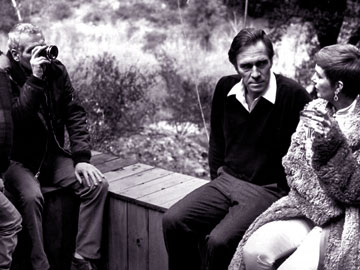
Paul Newman directing Christopher Plummer and Joanne Woodward in the TV movie "The Shadow Box."
Courtesy IMDB.com
Newman & Woodward Filmography
- Rachel, Rachel (1968)
- The Effect of Gamma Rays on Man-in-the-Moon Marigolds (1972)
- The Shadow Box (1980) TV Movie
- Harry and Son (1984) Woodward in smaller role as Lily
- The Glass Menagerie (1987)
Question 2 |
A | Joan Allen |
B | Ellen Burstyn |
C | Glen Close |
D | Holly Hunter |
E | Frances McDormand |
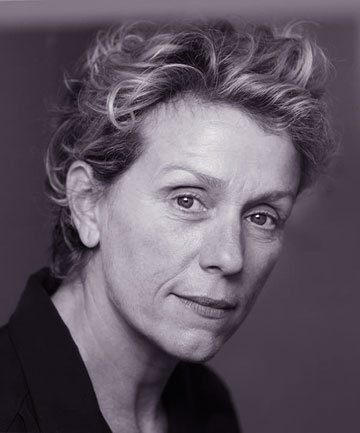
Frances Louise McDormand was born on June 23, 1957, in Gibson City, Illinois. Where she was adopted by Canadian-born parents. She earned a BA in theater from Bethany College in 1979 and an MFA from Yale University in 1982. Her career after graduation began onstage, and she has retained her association with the theater throughout her career. She soon obtained prominent roles in movies as well, first starring in Blood Simple (1984), in which she worked with future husband and filmmaker Joel Coen, whom she married that year. She frequently collaborated with Joel and his brother, Ethan Coen as writer, later co-director.
McDormand's skilled and versatile acting has been recognized by both the critics and the Academy, and in addition to many critics' awards, she has been nominated for an Academy Award six times - Supporting in Mississippi Burning (1988), Almost Famous (2000), and North Country (2005), - and winning the Best Actress Oscar in the lead role in Fargo (1996), Three Billboards Outside Ebbing, Missouri (2017), and Nomadland (2020). She also won a Best Picture Oscar as co-producer of Nomadland. Keenly intelligent and possessed of a sharp wit, McDormand is the antithesis of the Hollywood starlet - rather than making every role about Frances McDormand, she dissolves into the characters she plays.
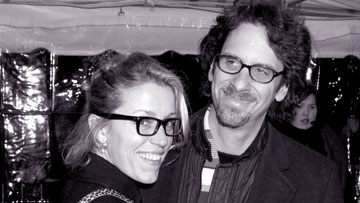
Frances McDormand and Joel Coen. Courtesy IMDB.com
Frances McDormand and Joel Coen Filmography
- The Tragedy of Macbeth (2021)
- Hail, Caesar! (2016) Co-director Ethan Coen
- Burn After Reading (2008) Co-director Ethan Coen
- The Man Who Wasn't There (2001)
- Fargo (1996) Co-director Ethan Coen
- The Hudsucker Proxy (1994)
- Raising Arizona (1987)
- Blood Simple (1984)
- 1991 Barton Fink, Stage Actress (voice, uncredited)
- 1990 Miller's Crossing, Mayor's Secretary (uncredited)
Question 3 |
A | Jill Clayburgh |
B | Faye Dunaway |
C | Marsha Mason |
D | Gena Rowlands |
E | Carrie Snodgress |
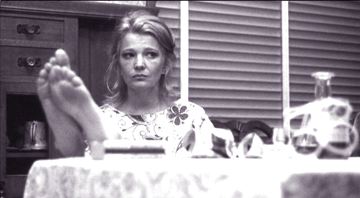
Gena Rowlands as Mabel Longhetti in John Cassavetes "A Woman Under the Influence."
Courtesy IMDB.com
Virginia Cathryn "Gena" Rowlands is an American film, stage, and television actress, born June 19, 1930 in Cambria, Wisconsin. Her father was of Welsh descent, her mother with English ancestry. Her career in the entertainment industry has spanned over six decades. A four-time Emmy and two-time Golden Globe winner, she is known for her collaborations with director John Cassavetes in seven films. Earlier she had moved to New York City to study drama at the American Academy of Dramatic Arts where the do-eyed beauty met actor Cassavetes when they were both students. In 1962, Rowlands co-stared with Kirk Douglas as his former lover in her breakout performance in Lonely Are the Brave.
Rowlands and Cassavetes married on April 9, 1954, which lasted until his death on February 3, 1989. They had three children, all actor-directors: Nick, Alexandra, and Zoe. She's also acted beside her husband in the non-Cassavetes directed films: Machine Gun McCain (1969),Two-Minute Warning (1976) and Tempest) (1982), directed by Paul Mazursky. The T-Boy Society of Film and Music recently selected Rowlands for her role as a woman suffering from mental issue in Cassavetes' A Woman Under the Influence as the greatest lead performance in film history. In 2021, The New Yorker stated, The most important and original movie actor of the past half century-plus is Gena Rowlands.
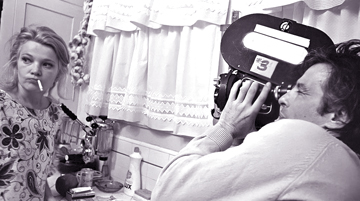
Director John Cassavetes shooting Gena" Rowlands in "A Woman Under the Influence."
Photo by Sam Shaw Inc./Le Figaro.
Gena Rowlands and John Cassavetes Filmography
- Love Streams (1984)
- Gloria (1984)
- Opening Night (1984)
- A Woman Under the Influence 1984
- Minnie and Moskowitz 1984
- Faces 1984
- A Child Is Waiting (1963)
- (uncredited) role in Shadows as Woman in Nightclub Audience
Question 4 |
A | Anne Baxter |
B | Rita Hayworth |
C | Oja Kodar |
D | Jeanne Moreau |
E | Alida Valli |
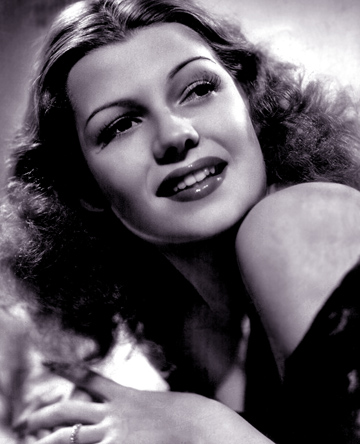
Rita Hayworth was born Margarita Carmen Cansino on October 17, 1918,
in Brooklyn, New York, into a family of dancers. Her father was from
Spain, while her mother was of mostly Irish descent.
Rita studied as a dancer in order to follow in her family's footsteps,
joining then on stage when she was eight years old, followed by appearing
with them in her first film, La Fiesta (1926). The famous red hair
was not her natural color (which was brunette). When she was signed a studio
contract at Columbia Pictures, studio head Harry Cohn changed her surname to
Hayworth and raised her hairline by electrolysis, where she underwent years
of painful electrolysis to make it higher. She cemented her image as the definite
femme fatale in Gilda, a 1946 film noir directed by Charles Vidor
and photographed by Rudolph Maté.
Hayworth married iconic film director Orson Welles in 1943 (divorced in 1948).
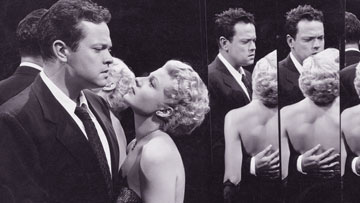
Welles cast Hayworth in his landmark film, The Lady from Shanghai. He decided to have her hair cut and bleached, which caused a storm of controversy with many believing it contributed to the film's poor box-office. Today, the film is regarded as a towering cinematic masterpiece. Its hall of mirrors scene among many of the film's highpoints. Welles once revealed that Hayworth detested her father because she suffered from merciless beatings and sexual abuse.
Question 5 |
A | Jane Birkin |
B | Lea Massari |
C | Jeanne Moreau |
D | Vanessa Redgrave |
E | Monica Vitti |
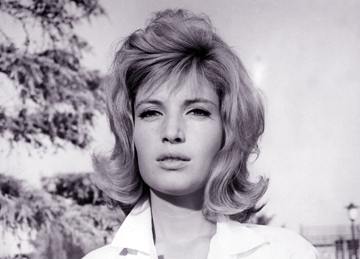
Monica Vitti. Courtesy IMDB.com
Monica Vitti was born on November 3, 1931 in Rome, Lazio, Italy as Maria Luisa Ceciarelli. She is an actress best known for her work with film director and husband, Michelangelo Antonioni in his early-to-mid 1960s films. In 1957 she joined Antonioni's Teatro Nuovo di Milano and dubbed the voice of Dorian Gray in the director'sIl Grido (1957). She played a leading role in Antonioni's internationally praised film L'Avventura (1960), and is also credited with helping Antonioni raise money for the production and sticking with him through daunting location shooting. L'Avventura made Vitti an international star, where her image later appeared on an Italian postage stamp commemorating the film. After working with Antonioni, Vitti changed focus and began making comedies, working with director Mario Monicelli on many films. She has appeared with Marcello Mastroianni, Alain Delon, Richard Harris, Terence Stamp, Michael Caine, and Dirk Bogarde.
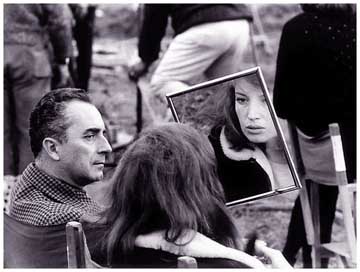
Michelangelo Antonioni and Monica Vitti on the set of "Red Desert" (1964).
Courtesy IMDB.com
Michelangelo Antonioni and Monica Vitti Filmography
- The Mystery of Oberwald (1980)
- Red Desert (1964)
- L'Eclisse (1962)
- La Notte (1961)
- L'Avventura (1960)
Trivia 59
DIRECTORS AND THEIR ACTRESS WIVES

Nicholas Ray directing actress & wife Gloria Grahame and Humphrey Bogart in “In a Lonely Place” (1950) Photo courtesy of Photofest.
Cinema and Romance is in the air. So, the theme for trivia 59 will be devoted to film directors who directed their own actress wives.
No one will see your answer except for you.
For more on cinema, see Traveling Boy's The 20 Best Films of 1971, Part One

Congratulations!
You have completed DIRECTORS AND THEIR ACTRESS WIVES.

You scored %%SCORE%% out of a possible 5 points.
Your performance was: %%RATING%%
Question 1 |
A | Anouk Aimee |
B | Claudia Cardinale |
C | Sophia Loren |
D | Anna Magnani |
E | Giuletta Masina |

Federico Fellini and Giuletta Masina in Venice.
Courtesy: IMDB.Com
EXTRAS: Italian film icon Federico Fellini directed actress and wife Giuletta Masina in seven movies. They were married from 1943 until his death in 1993. They had one child. Together they are buried in the same tomb in Rimini, Italy, Fellini’s place of birth.
Giulietta Masina (1921–1994) was born in San Giorgio di Piano, Italy, and spent part of her teenage years living in Rome, where she cultivated a passion for the theater and studied for a degree in philosophy. She began her career with popular radio shows with scripts written by Fellini. The following year she married Fellini and became the inspirational muse for many of his films.

Giuletta Masina in Nights of Cabiria.
Courtesy: IMDB.Com.
In Fellini’s 1950’s period, he was influenced by Charles Chaplin and the director’s theme of the road. In a sense, Giuletta Masina played Chaplin’s Little Tramp in La Strada (1954) and Nights of Cabiria (1957). Both films won Academy Awards for Best Foreign Language Film. Fellini described the two films as having been "inspired" by Masina's "humanity."
Federico Fellini & Giulietta Masina Filmography
- Variety Lights (1950) Co-directed with Alberto Lattuada.
- The White Sheik (1952)
- La Strada (1954)
- Il Bidone (1955)
- Nights of Cabiria (1957)
- Juliet of the Spirits (1965)
- Ginger and Fred (1986)
Question 2 |
A | Juliet Berto |
B | Isabelle Huppert |
C | Anna Karina |
D | Marie-France Pisier |
E | Romy Schneider |
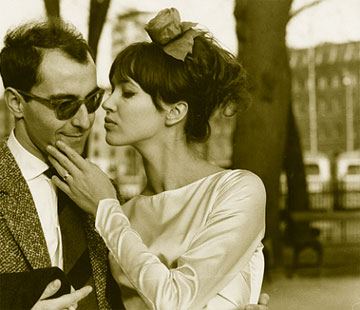
EXTRAS:
Jean-Luc Godard first noticed Anna Karina in a Palmolive ad and tried to cast her in a cameo role in his first feature film, Breathless (1960). She was told that she had to be nude and refused to play in the movie. A few months later, Godard offered her another part in his second film, Le Petit Soldat, (made in 1961, but not released until 1963 due to the political content of the war in French Algeria). Later they were married in 1961. They made seven features and one short sketch film together, and she became famous as the face of the Nouvelle Vague.
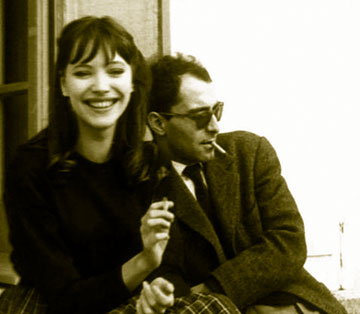
Hanne Karin Bayer (1940–2019) was born in Denmark, and at age seventeen hitchhiked to Paris and learned French by going to the movies. She soon met Coco Chanel and Pierre Cardin and became a popular model. Upon her meeting with Godard she decided to focus on screen acting and ended up appearing in seven features and one short sketch film by him. Fluent in five languages: French, Danish, English, Swedish and Italian, she has worked with the film directors Agnès Varda, Jacques Rivette, George Stevens, Volker Schlöndorff, George Cukor and Rainer Werner Fassbinder.
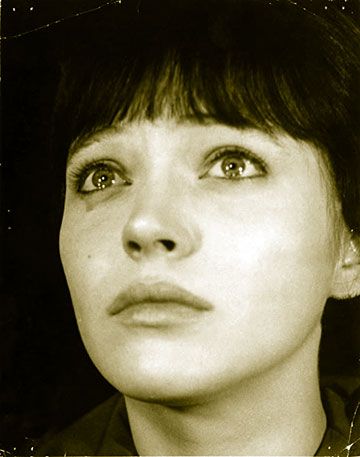
Anna Karina in My Life to Live (1962). Courtesy: IMDB.com.
"A whole book could also be written about the evolution of Karina’s close-ups in Godard’s films—how they go from fascination, to observation, to careful adoration and finally to nostalgia. But her relation to the camera also changes, as the relationship with the man behind it does—from shyness to content comfort in front of it, from sensuality to coldness, from ignoring it to commanding it. The exchange of looks mediated by the camera is varied and extremely nuanced. – Miranda Popkey, the hairpin."
Jean-Luc Godard & Anna Karina Filmography
- Le Petit Soldat (1961)
- A Woman Is a Woman (1961)
- Vivre Sa Vie (1962)
- Band of Outsiders (1964)
- Alphaville (1965)
- Pierrot le Fou (1965)
- Made in U.S.A (1966)
- The Oldest Profession (1967) Sketch film.
Question 3 |
A | Claire Bloom |
B | Virginia Cherrill |
C | Paulette Goddard |
D | Edna Purviance |
E | Martha Raye |

Charles Chaplin and third wife, Paulette Goddard. Courtesy: IMDB.com
EXTRAS:
Paulette Goddard met Iconic director, writer and actor Charles Chaplin in 1932. Goddard mesmerized Chaplin with her stunning natural beauty and soon they became an item in Hollywood. They secretly married the first week in June, 1936, in Canton, China, while on a world cruise. He eventual said, "I am writing a screen play for you, and its title is Modern Times.
Marion Goddard Levy (1910–1990) was born in Whitestone Landing, New York. She began to model for local department stores before she made her debut with Florenz Ziegfeld's Follies at the age of 13, where she gained fame as the girl on the crescent moon. She moved to Hollywood at age sixteen, and appeared in small film roles. Goddard was still working for less than $100 a week as a chorus girl for the Goldwyn Studios. Chaplin was true to his word, and cast her in Modern Times (1936), which was a big hit, but her movie career was not going anywhere because of her relationship with the controversial Chaplin. They made a second film in 1940 together, The Great Dictator; Chaplin’s first complete sound film.
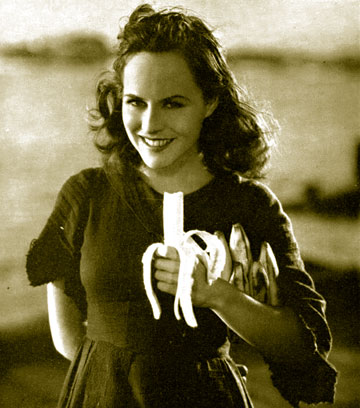
Paulette Goddard in Modern Times.
Courtesy: IMDB.Com.
Working together on Modern Times put a strain on Chaplin and Goddard's relationship. Contrary to the way young actresses were presented on screen, Goddard was to wear shabby clothing and no make-up. When she first arrived on the set with her beautifully coiffed hair, Chaplin dumped a bucket of water over her head. He insisted that she either be barefoot or wear shoes without heels to ensure that she is always shorter than his 5 ft 4 Little Tramp.
Chaplin then cast Goddard in the leading female role in his first all-sound, all talkie film, The Great Dictator (1940.) He named her character after his mother, Hannah, where she played a cleaner. He insisted that she scrub the floor of the whole set only for her to refuse. Chaplin stopped filming until she agreed to do so. Their relationship was already on the rocks, and the couple split shortly after the 1940 premiere of their film. Goddard obtained a quickie divorce in Mexico and allegedly received a handsome settlement. The 54-year-old Chapin married wife number four, 18-year-old Oona O'Neill, daughter of playwright Eugene O'Neill, while Goddard’s husband number three was actor Burgess Meredith.
Charles Chaplin & Paulette Goddard Filmography
- Modern Times (1936)
- The Great Dictator (1940)
Question 4 |
A | Isabelle Adjani |
B | Stéphane Audran |
C | Emmanuel Berat |
D | Dominque Sanda |
E | Isabelle Hupert |
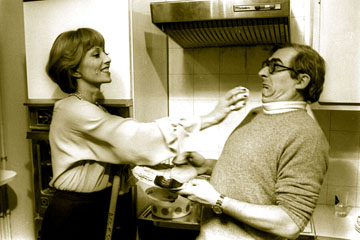
Stéphane Audran and husband, director & gourmet chef Claude Chabrol in the kitchen. Courtesy: IMDB.Com
EXTRAS: French director Claude Chabrol cast Stéphane Audran in his second film, Les Cousins. They started to date which led to a 1964 marriage which lasted for 16 years until divorce. They had one child together. Chabrol later commented, “I found myself becoming more interested in her as an actress than a wife.” Audran frequently stated she owed everything to Chabrol. With the success of Audran’s role in Chabrol’s Les Biches (1968), he started to cast her in roles of glacial bourgeois ladies, the epitome of Parisian chic. This led the two of them to a successful cycle of thrillers in the late 60s-early 70s. Colette Suzanne Jeannine Dacheville was born in Versailles, Seine-et-Oise [now Yvelines], France in 1932. Having taken acting lessons, she appeared in theatrical productions, but failed to build a noteworthy stage career. After playing a few tiny roles on film, she asked emerging French New Wave star Gérard Blain, whom she knew from acting courses, if he could introduce her to director Claude Chabrol. Blain had already acted in Chabrol’s successful first film, Le Beau Serge (1958), and was going to team up again in The Cousins (1959). Blain granted her wish and introduced her to Chabrol, who gave her a role in Les Cousins. They made 24 films together.
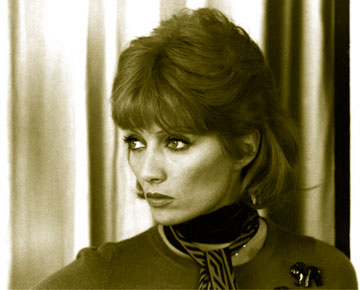
Stéphane Audran was the very essence of Parisian chic during the Nouvelle Vague. Courtesy: IMDB.Com
While Stéphane Audran is best known for her performances in films by Chabrol, she also appeared in Luis Buñuel’s Academy Award winning, The Discreet Charm of the Bourgeoisie (1972); Samuel Fuller’s The Big Red One (1980) and Babette’s Feast (1987), the first Danish movie to win an Academy Award for best foreign language film. She died at the age of 85 on March 27, 2018 in Neuilly-sur-Seine, Hauts-de-Seine, France.
Question 5 |
A | Ingrid Bergman |
B | Claudia Cardinale |
C | Sophia Loren |
D | Anna Magnani |
E | Jean Seberg |

Roberto Rossellini and Ingrid Bergman at Cannes Film Festival.
Courtesy: IMDB.Com
EXTRAS: Ingrid Bergman was one of the greatest actresses from Hollywood's lamented Golden Era. Her stunning natural beauty and immense acting talent made her one of the most celebrated figures in the history of American cinema. Great performances result from an actor’s collaboration with great directors, and Ingrid Bergman went further—and sacrificed more—than did any other actor in order to work with a true cinematic genius, Italian director Roberto Rossellini. While at the peak of her popularity, Bergman was so taken upon seeing Rossellini’s Italian neorealism films, Rome, Open City (1945)and Paisan (1946), that she sent the director a letter, introducing herself and offering her talents in any film of his choice.
Ingrid Bergman was born on August 29, 1915 in Stockholm, Sweden, to a German mother who died when she was only two, and a Swedish father that passed away when she was twelve. After finishing formal schooling, she enrolled at the Royal Dramatic Theatre School in Stockholm but decided that screen acting was her passion. In 1936, Bergman appeared in the Swedish film, Intermezzo, which caught the eye of American producer David O. Selznick, who signed her to a contract. She moved to California and reprised her original role in an English language remake of Intermezzo (1939). The film was a hit and so was Bergman.
Her beauty was infectious and her acting and attention to craft indicated to moviegoers that her films represented a tradition of quality. Her impressive performances and awards were seemingly endless, appearing in Casablanca (1942), For Whom the Bell Tolls (1943), an Oscar-winning performance in George Cukor’s Gaslight (1944), and three films by Alfred Hitchcock. But it was her portrayal of a nun in Leo McCarey’s The Bells of St. Mary's (1945) and title role in Joan of Arc (1948) that cemented her off-screen image to the public as a moralistic, saint-like character which she played on the screen. But that was before Rossellini.
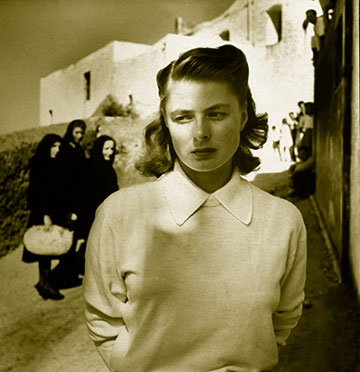
Ingrid Bergman as displaced war victim in Roberto Rossellini’s Stromboli. Courtesy: IMDB.Com
In 1949 Bergman arrived in Italy to film Stromboli (1950) with Rossellini, and they quickly fell in love with each other. Bergman left her husband, Petter Lindström, and their young daughter, Pia Lindström, to live with Rossellini. When she and Rossellini made Stromboli, Bergman was pregnant with his child. She divorced Lindström, but the divorce hadn’t yet come through, and America's "moral guardians" were outraged. She decided to remain in Italy, where a son was born, followed by twins, Isotta and Isabella Rossellini, who became a world-famous model and actress, and later spouse of American director Martin Scorsese.
Bergman was denounced in the press, in pulpits, and even in the Senate; local officials called for boycotts on all of her films, and it was beside the point whether she was persona non grata in Hollywood, because she had no intention, at the time, of working in Hollywood again.
Together, Bergman and Rossellini made six films that are works of both sociopolitical concern and metaphysical melodrama, each starring Bergman as a woman experiencing physical dislocation and psychic torment in post-World War Two Italy.
In 1957 they divorced, partly due to Rossellini not wanting her to work with any director other than himself, which caused trouble in their work together and marriage. Plus, Rossellini had an extramarital affair with the Indian screenwriter Sonali Senroy DasGupta whom he later married. Ingrid continued to make films in Italy and finally returned to the English-speaking world in the title role in Anastasia (1956) to applause and forgiveness, and winning her second Academy Award. She continued to bounce back and forth from Europe and Hollywood, culminating in her final big-screen performance in 1978's Swedish film Autumn Sonata, directed by fellow Swede Ingmar Bergman, where she received her final Academy Award nomination. Ingrid Bergman died from cancer in 1982 on her 67th birthday.
Roberto Rossellini & Ingrid Bergman Filmography
- Stromboli (1950)
- Europe '51 (1952)
- We, the Women (1953)
- Joan of Arc at the Stake (1954)
- Fear (1954)
- Journey to Italy (1954)
Trivia #58 American History
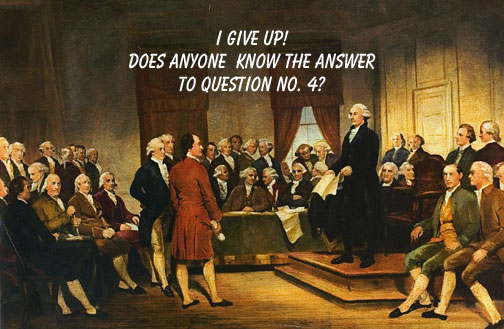
Are you up to the challenge?

Trivia #58 is devoted to History, Sports and Arts. No one will see your answers except you.

Congratulations!
You have completed Are you up to the challenge?.

You scored %%SCORE%% out of a possible 5 points.
Your performance was: %%RATING%%
Question 1 |
A | Baseball |
B | Cricket |
C | Hockey |
D | Soccer |
E | Tennis |
Soccer is the most popular spectator sport

The Iran-Morocco match, 2018 FIFA World Cup. Photograph courtesy of Кирилл Венедиктов via Wikimedia Commons
List of the World’s most popular spectator sports :
- Soccer: 4 Billion
- Cricket: 2.5 Billion
- Hockey: 2 Billion
- Tennis: I Billion
- Baseball: 500 Million
Question 2 |
A | Belgium |
B | Britain |
C | Canada |
D | Norway |
E | USA |
Canada liberated the Netherlands in 1945.
In the final months of the Second World War, Canadian forces were given the important and deadly task of liberating the Netherlands from Nazi occupation. From September 1944 to April 1945, the First Canadian Army fought German forces on the Scheldt estuary — opening the port of Antwerp for Allied use — and then cleared northern and western Netherlands of Germans, allowing food and other relief to reach millions of desperate people. More than 7,600 Canadian soldiers, sailors and airmen died fighting in the Netherlands.
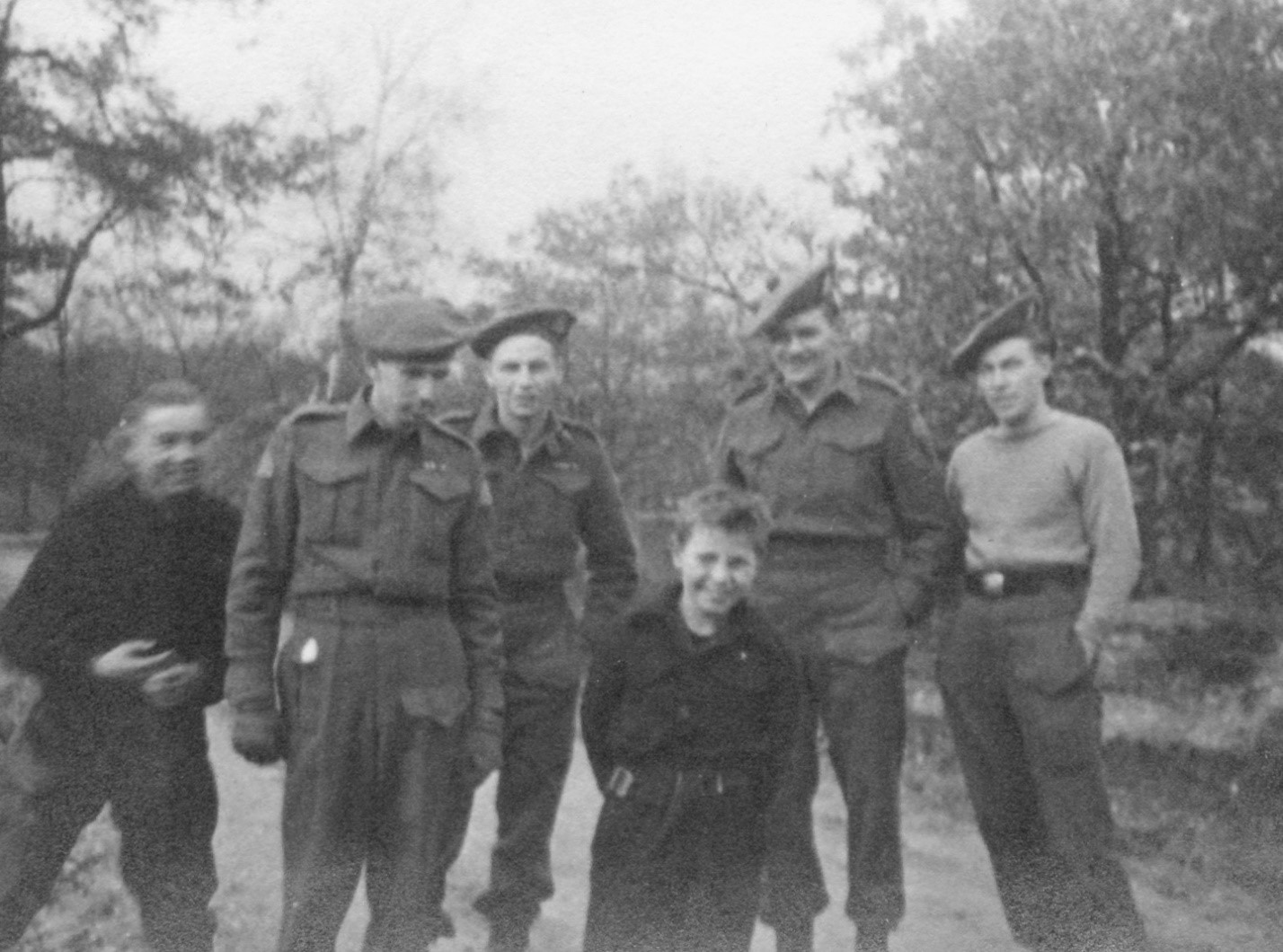
Canadian Scottish Regiment troops posing with liberated Dutch children (1945).
Courtesy Private Floyd Watkins via Wikimedia Commons
Today, Canada is fondly remembered by the Dutch for ending their oppression under the Nazis.
An estimated 301,000 Dutch people died during the Second World War, including at least 280,000 civilians. Approximately 104,000 were victims of the Holocaust. Another 20,000 died of famine-related causes.
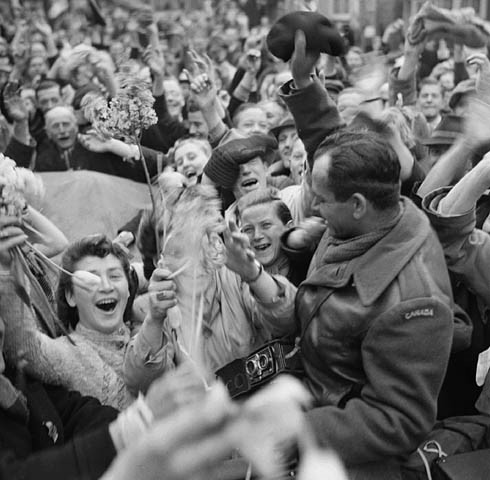
Dutch civilians celebrating the liberation of Utrecht by the Canadian Army.Commons
Courtesy Alexander Mackenzie Stirton, Canadian Department of National Defense,
Question 3 |
A | Pete Best |
B | Billy J. Kramer |
C | Jerry Marsden |
D | Stuart Sutcliffe |
E | Klaus Voormann |
Stuart Sutcliffe was the fifth Beatle
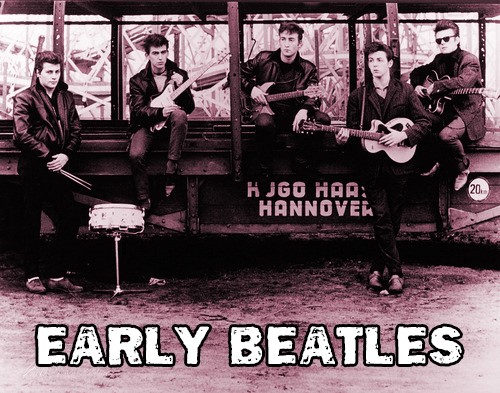
Pete Best, George Harrison, John Lennon, Paul McCartney & Stuart Sutcliffe in Hamburg.
The Fifth Beatle would be the person who was quite literally the Fifth person in the band, and that person was Stuart Sutcliffe. Pete Best once said, “Lots of people have laid claim to being the Fifth Beatle. I was the fourth…”
Stuart Sutcliffe was a member of the legendary band as the original bass guitarist, constituting the status as the Fifth Beatle.
Stuart Sutcliffe was born in Edinburgh Scotland in 1940, but his family moved to England shortly after. He happened to meet John Lennon at the Liverpool College of Art when he was introduced by a mutual friend. The three of them were all studying at the school, and Sutcliffe was noted as a brilliant painter.
When he was kicked out of his flat, Sutcliffe moved into a rundown area in Liverpool, where John Lennon moved in with him. Sutcliffe got involved with the Beatles when Lennon and McCartney convinced him to buy a bass guitar. Sutcliffe is credited along with Lennon for coming up with the band’s original name, the Beetles, inspired by Buddy Holly’s band, the Crickets.
Stuart Sutcliffe began playing gigs with the Beatles in Hamburg, which is where he met his fiance, German photographer and artist Astrid Kirchherr (May 1938 – May 2020. Together they are considered the originator of the Beatle haircut. Love Me Tender was reportedly Stuart Sutcliffe’s signature song. Apparently when he sang it, he received more cheers from the crowd than the other Beatles.
Question 4 |
A | True |
B | False |
FALSE! Constitution Day was established in 1787

In 1940, Congress and the President FDR passed a resolution creating “I Am an American Day,” observed on the third Sunday in May. In 1952, the holiday was renamed to “Constitution Day” and moved to September 17, the day in 1787 that the Constitution was signed. Constitution Day and Citizenship Day is a single celebration that commemorates the formation and signing of the US Constitution while also recognizing both naturalized citizens and those born in the US. It's a day to learn about these subjects, as well as a day many people become naturalized citizens in group ceremonies. (On average, about 700,000 people become US citizens every year.)
Question 5 |
A | True |
B | False |
The John Ford Calvary Trilogy consisted of Fort Apache, She Wore a Yellow Ribbon and Rio Grande.
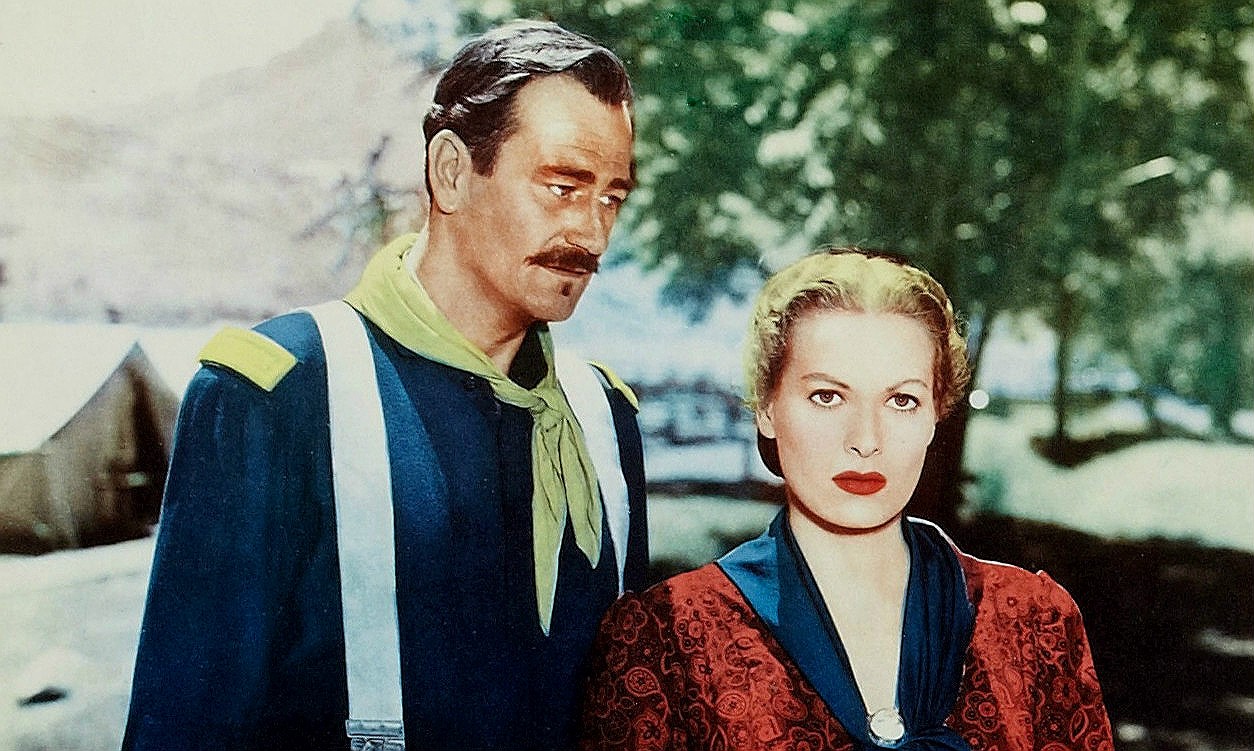
Photo from the film ‘’Rio Grande’’ with John Wayne and Maureen O’Hara. Courtesy of Wikimedia Commons.
John Ford is, arguably, The Great American Director. When Orson Welles, who repeatedly screened Ford's Stagecoach (1939) as a crash course in filmmaking before helming his first film, Citizen Kane (1941), was asked who his three favorite directors were, he answered, "John Ford, John Ford, and John Ford." Along with D.W. Griffith, who created the visual language of film used today, Ford came of age when movie production began shifting from its New York-New Jersey base to California in the second decade of the 20th Century He is considered an artist who helped define what America was on the screen. Ford's cinematic art is as much a part of Americana as a Frederic Remington painting of the Old West, a subject both portrayed in their respective artforms.

